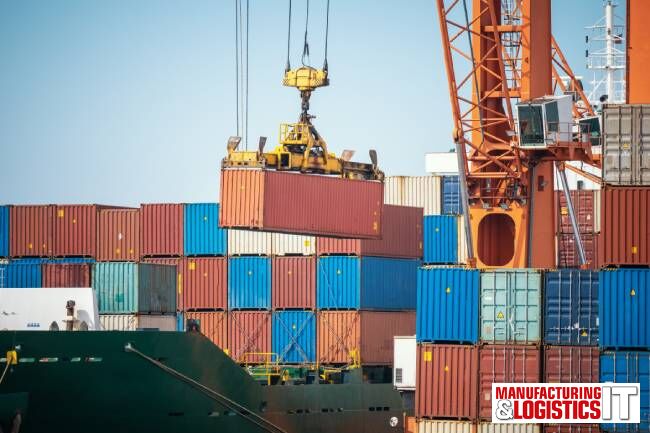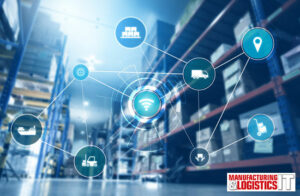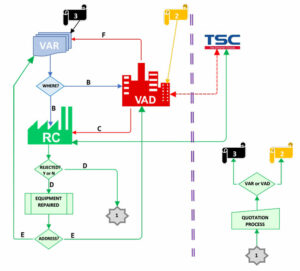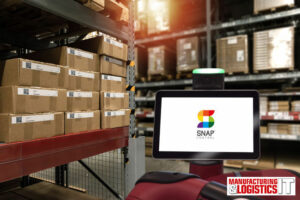Arup has launched its ‘Future of Goods Movement’ report, outlining the key drivers of change in global goods movement and exploring how the sector needs to anticipate and plan for the likely changes and shifts in the future of freight to ensure resilience of the global economy and a more sustainable planet.
The report emphasises how the transition of energy and industrial materials in the context of nations working to achieve net zero targets will have a significant impact on the future of freight.

Energy products made up 36% of global seaborne trade in 2021, and with seaborne trade making up 80% of global freight, this represents a significant portion of the global movement of goods.
Around 80% of the world’s economy, and 77% of global greenhouse gases, are now covered by a national net zero target. The world’s most traded commodities are agricultural, energy, and metal products – products which are all directly subject to major transformation as a result of committed efforts to tackle climate change and reduce greenhouse gas emissions.
The report unpacks five key shifts that Arup anticipates in the sector:
- The transition to net zero emissions and the need to transform the management of overconsumption and waste.
- The need to prioritise resilience against growing environmental, social, and economic risks.
- The changing nature of global economic powers and the role of different nations in consumption and production.
- New technology and changes in supply chains, consumer preferences, and retail business models.
- The energy and industrial materials transition. The fifth shift, centred on the energy transition, is closely related to the first shift, the need to achieve net zero emissions and reduce overconsumption and waste. The report focuses on energy and materials separately due to the direct implications these will have on the goods and volumes that need to be transported in the future.
The report looks at the systems and networks that underpin goods movements beyond transport. It explores the current race towards supply chain optimisation. Scenarios by McKinsey and Company suggest that just one lengthy shock can wipe out 30% to 50% of annual earnings for businesses. Companies are now starting to think about diversifying their sourcing or manufacturing bases, obtaining a greater degree of transparency across their supply chains, and embedding in redundancies – by stockpiling, and identifying alternative pathways for sourcing, processing, and transporting goods.
Trends in manufacturing are shifting too with an increase in reshoring. The report highlights how two in five UK-based small businesses are considering a switch to UK manufacturers as rising shipping costs bite into margins and threaten growth, according to a survey of 750 firms by logistics platform ShipBob.
This report is part of Arup’s wider efforts across transport and logistics to support increased sustainability in the often invisible networks and systems we all depend on.
Arup’s UKIMEA Transport leader John Fagan said: “At a pivotal time for the ever-changing freight sector, Arup’s report outlines the critical drivers of change that will likely shape the future of freight – a sector which impacts the transport ecosystem, providing the majority of resources which enrich our daily lives.
“With the formation of the Freight Council, the UK has created a forum for engagement across all modes of freight and logistics, and an opportunity to embrace the changes and challenges in the movement of goods collectively, working to a longer term nationwide strategy for goods movement”
Arup’s Logistics and Supply Chain Director, Darren Briggs said:
“Post pandemic and in the wake of geopolitical tensions and climate change, the actors involved in the movement of goods are all too aware of how unexpected circumstances can wreak havoc in supply chains.
“Arup’s report helps to equip those who keep goods across the globe moving to build future-proof strategies that support the future of freight. In recent years, we have seen a greater spotlight on how we source and move our goods. Planners and logistics operators can’t afford to take for granted systems and processes that have served the sector well previously. There is a real opportunity to innovate and reset in the sector, to get ahead of the challenges that are fast coming down the track.”
- SEO Powered Content & PR Distribution. Get Amplified Today.
- PlatoData.Network Vertical Generative Ai. Empower Yourself. Access Here.
- PlatoAiStream. Web3 Intelligence. Knowledge Amplified. Access Here.
- PlatoESG. Carbon, CleanTech, Energy, Environment, Solar, Waste Management. Access Here.
- PlatoHealth. Biotech and Clinical Trials Intelligence. Access Here.
- Source: https://www.logisticsit.com/articles/2023/11/23/arup-highlights-future-drivers-of-change-in-global-goods-movement
- :has
- :is
- $UP
- 2021
- 750
- a
- About
- According
- Achieve
- across
- actors
- against
- Agricultural
- ahead
- All
- alternative
- an
- and
- annual
- anticipate
- anticipates
- ARE
- AS
- At
- aware
- BE
- Beyond
- build
- business
- businesses
- by
- CAN
- chain
- chains
- challenges
- change
- Changes
- changing
- circumstances
- Climate
- Climate change
- closely
- collectively
- coming
- committed
- Commodities
- Companies
- company
- considering
- consumer
- consumption
- context
- Costs
- Council
- covered
- created
- critical
- Current
- daily
- Darren
- Degree
- depend
- different
- direct
- directly
- Director
- down
- drivers
- due
- Earnings
- Economic
- economy
- ecosystem
- efforts
- embedding
- embrace
- Emissions
- energy
- engagement
- enrich
- ensure
- environmental
- ever-changing
- explores
- Exploring
- FAST
- fifth
- firms
- First
- five
- focuses
- For
- formation
- Forum
- freight
- future
- GAS
- geopolitical
- get
- Global
- Global Economic
- Global economy
- globe
- goods
- granted
- greater
- greenhouse gas
- Greenhouse gas emissions
- Growing
- Growth
- Have
- helps
- highlights
- How
- HTTPS
- identifying
- Impact
- Impacts
- implications
- in
- Increase
- increased
- industrial
- innovate
- into
- invisible
- involved
- IT
- ITS
- John
- jpg
- just
- just one
- Keep
- Key
- launched
- leader
- likely
- Lives
- logistics
- longer
- LOOKS
- made
- major
- Majority
- Making
- management
- Manufacturers
- manufacturing
- margins
- materials
- McKinsey
- metal
- models
- modes
- more
- most
- move
- movement
- movements
- moving
- National
- Nations
- Nationwide
- Nature
- Need
- needs
- net
- networks
- now
- obtaining
- of
- often
- on
- ONE
- operators
- Opportunity
- or
- our
- out
- outlines
- outlining
- pandemic
- part
- pathways
- pivotal
- plan
- planet
- platform
- plato
- Plato Data Intelligence
- PlatoData
- powers
- preferences
- previously
- prioritise
- processes
- processing
- Production
- Products
- providing
- Race
- real
- recent
- reduce
- related
- report
- represents
- resilience
- Resources
- result
- retail
- rising
- risks
- Role
- Said
- scenarios
- sector
- seen
- served
- Shape
- shift
- SHIFTING
- Shifts
- Shipping
- significant
- small
- small businesses
- Social
- Source
- Sourcing
- Spotlight
- Starting
- Stockpiling
- strategies
- Strategy
- subject
- suggest
- supply
- supply chain
- Supply chains
- support
- Survey
- Sustainability
- sustainable
- Switch
- Systems
- tackle
- Take
- Target
- targets
- Technology
- tensions
- term
- that
- The
- The Future
- the UK
- their
- There.
- These
- think
- this
- those
- threaten
- time
- to
- too
- towards
- track
- trade
- traded
- Transform
- Transformation
- transition
- Transparency
- transport
- transported
- transporting
- two
- Uk
- underpin
- Unexpected
- volumes
- Wake
- Waste
- we
- WELL
- which
- WHO
- wider
- will
- wipe
- with
- working
- world’s
- years
- zephyrnet
- zero












